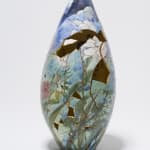Claudia Clare
Remembering Atefeh, 2011
This pot was made in remembrance of Atefeh Rajabi Sahaaleh, (b. 1988 – d. 15th August 2004) who was executed, aged sixteen, for ‘crimes against chastity,’ in Neka, Mazandaran, in...
This pot was made in remembrance of Atefeh Rajabi Sahaaleh, (b. 1988 – d. 15th August 2004) who was executed, aged sixteen, for ‘crimes against chastity,’ in Neka, Mazandaran, in Northern Iran on August 15th 2004.
Clare created this work in order to the life of Atefeh, and the events leading to her execution into a wider social context in which many girls and young women in Iran have been, and still are, imprisoned and executed for, ‘crimes against chastity,’ or ‘zena.’ The artist comments "These girls do not set out to be political activists, they are not heroes of the revolution, nor are they saints or martyrs. They are ordinary, anonymous girls and women from villages, small towns and big cities alike, whose behaviour and whose very existence is criminalised."
Nasrine Satoudeh, a human rights lawyer currently serving an eleven-year prison sentence in Iran makes the following observation on Atefeh’s case and the countless others like hers:
The courts somehow deal much more rigorously with the women than with the men. The weakest point in our downfall is that this is happening right in front of our eyes but, sadly, we pretend that we just don’t see it.
This pot was first built and bisque fired in 2010. It was hand built, (using the coil method), and the inside painted yellow. The external painting is of of lilies and roses - iconic flowers associated with love and innocence - here are entwined with wild flowers - suggesting both the neglect suffered by Atefeh and also her rebellious spirit.
The artist broke the pot on the 15th August 2011 by Neda's Tree in Hyde park as part of a ceremony.
The ceremony took place in Hyde Park seven years after the sixteen-year old Atefeh was hanged. Eighteen people, mostly Iranians living in London, gathered under a tree, at sunset, opposite the Iranian Embassy. Candles were lit, to flute accompaniment, and, after readings in English and Farsi, a minute’s silence was held which was broken with the smashing of the Atefeh’s pot. A rug caught the scattering shards and the ceremony closed with more music. The rug was rolled up and the pieces conveyed to the studio for reconstruction. The images of Atefeh were fired into the glazed interior and the shards pieced together, leaving some gaps in the reconstruction, so that the internal imagery and colour would be visible.
The breaking and mending of the pot is a metaphor for the shattering of the lives and the process of survival of ‘piecing myself back together.’ It is also a material equivalent of ‘breaking the silence,’ about rape and sexual violence.
Clare created this work in order to the life of Atefeh, and the events leading to her execution into a wider social context in which many girls and young women in Iran have been, and still are, imprisoned and executed for, ‘crimes against chastity,’ or ‘zena.’ The artist comments "These girls do not set out to be political activists, they are not heroes of the revolution, nor are they saints or martyrs. They are ordinary, anonymous girls and women from villages, small towns and big cities alike, whose behaviour and whose very existence is criminalised."
Nasrine Satoudeh, a human rights lawyer currently serving an eleven-year prison sentence in Iran makes the following observation on Atefeh’s case and the countless others like hers:
The courts somehow deal much more rigorously with the women than with the men. The weakest point in our downfall is that this is happening right in front of our eyes but, sadly, we pretend that we just don’t see it.
This pot was first built and bisque fired in 2010. It was hand built, (using the coil method), and the inside painted yellow. The external painting is of of lilies and roses - iconic flowers associated with love and innocence - here are entwined with wild flowers - suggesting both the neglect suffered by Atefeh and also her rebellious spirit.
The artist broke the pot on the 15th August 2011 by Neda's Tree in Hyde park as part of a ceremony.
The ceremony took place in Hyde Park seven years after the sixteen-year old Atefeh was hanged. Eighteen people, mostly Iranians living in London, gathered under a tree, at sunset, opposite the Iranian Embassy. Candles were lit, to flute accompaniment, and, after readings in English and Farsi, a minute’s silence was held which was broken with the smashing of the Atefeh’s pot. A rug caught the scattering shards and the ceremony closed with more music. The rug was rolled up and the pieces conveyed to the studio for reconstruction. The images of Atefeh were fired into the glazed interior and the shards pieced together, leaving some gaps in the reconstruction, so that the internal imagery and colour would be visible.
The breaking and mending of the pot is a metaphor for the shattering of the lives and the process of survival of ‘piecing myself back together.’ It is also a material equivalent of ‘breaking the silence,’ about rape and sexual violence.
Join our community of art lovers
Want to be the first to hear our news and get invitations to special events and private views? Leave us your email. We won't sell it, we won't pester you, that's a promise. We just to share with you about art.
* denotes required fields
We will process the personal data you have supplied to communicate with you in accordance with our Privacy Policy. You can unsubscribe or change your preferences at any time by clicking the link in our emails.



